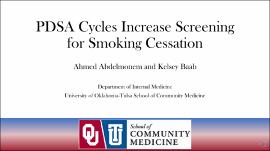| dc.description.abstract | Introduction: Smoking represents the leading cause of preventable disease, disability and death in the United States, disproportionately affecting lower-income populations1. Smoking cessation has been shown to reduce the associated health risks and to lead to a decrease in early mortality. Due to the significant impact of smoking on our patient population, the students at OU’s student-run, free clinic, Bedlam Clinic, decided to implement a series of Plan-Do-Study-Act (PDSA) cycles to address this issue. PDSA cycles are widely used for quality improvement in healthcare systems and have been shown to improve outcomes2. Our aim was to improve tobacco screening and counseling in OU Bedlam student-run clinic by 20% by June 2020.
Methods: From September 2019-May 2020, teams of third-year medical students, PA students, nursing students, social work students, and faculty attendings implemented PDSA rapid improvement cycles. The goal was to increase smoking screening and cessation education above the current baseline of 49.4% by the end of the year. Each individual team created a plan, which they implemented in the clinic. The number of screenings, counseling sessions, and smoking cessations were recorded per team. The teams met bi-monthly to discuss and improve upon the plan. By the third PDSA cycle, the entire clinic agreed to implement the protocol of the team with the largest increase in tobacco screenings. The protocol chosen involved an interdisciplinary approach: the nursing student initiated the screen, the Medical/PA student provided counseling for those interested, and the social work student provided resources for those motivated to quit smoking.
Results: At the first PDSA cycle, 49.4% of eligible patients at Bedlam Clinic had a tobacco screening completed, with an upper and lower confidence level of 53.6% and 45.1%. Monthly data points following the initial PDSA cycle were consistently above average. By July, 2020, after 4 PDSA cycles, the average tobacco screening rose from 49.4% to 59.8%.
Conclusion: Implementing a multidisciplinary, quality improvement project to increase smoking cessation screening at the OU Bedlam student-run clinic was successful. Tobacco screening at the Bedlam Clinic improved by 20.1% from its baseline. The PDSA cycles elucidated that documentation of the tobacco screening process was being recorded incorrectly in the EMR. Once this was established, we implemented a protocol ensuring that this important step was not forgotten. Specifically, nursing students documented the screening in the EMR at the beginning of the visit. This step was implemented across the entire clinic by February 2020, significantly improving tobacco screenings. This project demonstrates that a student-led, annual, QI project using simple rapid cycle improvement leads to improved patient care. These projects should continue to be implemented at the Bedlam Clinic and further expanded to the remaining OU clinics. | en_US |
